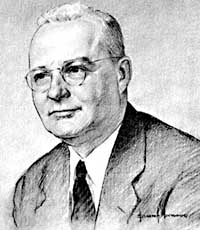“Midgley’s name is inseparably associated with four outstanding advances. The first was the discovery of the chemical antiknock agents. Tetra-ethyl lead, the principal one of these, has added immensely to the performance and efficiency of gasoline engines both in the air and on the ground. The second advance, which was necessary to the practical success of the first, was the extraction of bromine from sea water. The third was the utilization of fluorine to produce an altogether new series of refrigerating compounds, the only such compounds known which are stable, non-flammable, and completely non-toxic, and which are therefore indispensable in air-conditioning. The fourth advance was in the field of rubber, in which he extended the knowledge of the chemistry of vulcanization and of the fundamental composition of natural and synthetic rubbers.” – Biographical Memoir of Thomas Midgley Jr. 1889 – 1944 By Charles F. Kettering
He certainly sounds like quite the scientist, doesn’t he? No-one can deny that he was indeed gifted in the field of chemistry, despite the fact that he had never received and formal training as a scientist. His training was in Engineering, though after gaining an interest in the industrial applications of chemistry he ceased to continue his engineering work. Although his work was pioneering in some respects, it left a deadly trail behind him.
Tetra-ethyl Lead
In 1921, when working for General Motors, Midgley discovered that by adding lead to petrol he was able to prevent a problem known as ”knocking’. Knocking occurs when fuel burns too early in the internal combustion cycle and leads to noise and engine damage. The addition of lead, or ‘tetra-ethyl lead’ (also sometimes called ‘lead tetraethyl’, for some reason) to the petrol resulted in slightly slower rates of combustion, meaning that the knocking was prevented.
We can look back on this with the benefit of hindsight and think “Hey, lead is really dangerous, don’t add that”, but of course we have the benefit of knowledge. Surely they didn’t? Actually – surprisingly – the dangers of tetra-ethyl lead were well known at the time of discovery, yet this did not seem to sway the production of it.
In 1923, General Motors, Du Pont and Standard Oil of New Jersey formed a joint company titled the ‘Ethyl Gasoline Corporation’. They later adopted the shorter and less-toxic sounding name, ‘Ethyl’, no doubt a decision made by the PR department aimed to suppress public fear and increase company profitability. The additive was made available for public consumption on the 1st February 1923.
What are the dangers of Lead, then?
“Lead is a Neurotoxin. get too much of it and you can irrepairable damage the brain and central nervous system. Among the many symptoms associated with over-exposure are blindness, insomnia, kidney failure, hearing loss, cancer, palsies and convulsions. In its most acute form it produces abrupt hallucinations, disturbing to victims and onlookers alike, which generally then give way to coma and death. You really don’t want to get too much lead in your system.” -Bill Bryson, A Short History of Nearly Everything
Yet despite these dangers, lead was being used in a vast array of products, ranging from the lining of toothpaste tubes and water tanks to being used as a solder in food tins. Lead was also used in paints. Lead arsenate was even sprayed onto fruit as a pesticide! These applications were bad, but the worst application of all came in the form of petrol.
Almost as soon as production had started at the Ethyl plant, workers began to show the first signs of lead poisoning. The Ethyl corporation began its long-lasting policy of unyielding denial that their product had any connection to the illnesses. “These men probably went insane because they worked too hard”, was the comment made by one Ethyl spokesman to an audience of reporters when the outbreak of poisonings occurred.
It is hard to give exact figures of those that died and were injured by over-exposure to lead, largely due to cover-ups by the industry. However, it is known that at least 15 people died in the early days of production, and countless others were made ill.
“At times, however, suppressing the news became impossible – most notably in 1924 when, in a matter of days, five production- workers died and thirty-five more were transformed into permanent staggering wrecks at a single ill-vented facility.” – Bill Bryson, A Short History of Nearly Everything
Something had to be done, so Midgley took it upon himself to hold a demonstration where he illustrated just how harmless he believed lead to be. He did this by pouring tetra-ethyl lead over his hands and then holding a cup of it under his nose and inhaling it for sixty seconds. Whilst performing this deadly demonstration he was assuring reporters of how he could repeat this practice daily without harm. He did this whilst knowing full-well the dangers of lead poisoning due to having been over-exposed to the substance a few months previous to the demonstration.
Chlorofluorocarbons
After the ‘success’ of tetra-ethyl lead, Midgely moved onto his next deadly substance. Refrigerators used rather dangerous gasses that were deadly if they leaked. One devastating incident took place at a hospital in Cleveland, Ohio 1929 when a refrigerator killed more than one-hundred people. in 1930, Midgley was commissioned by General Motors to see if he could produce a better alternative to these deadly gasses. It needed to be stable, non-flammable, non-corrosive and safe to breathe. He devised a compound made from chlorine, fluorine and carbon – it was called Freon (also called dichlorodifluoromethane), a type of chlorofluorocarbon, or CFC.
Freon caught on quickly, and within a couple of years all refrigerators were using it. In addition to refrigerators it had found a use in many other applications too, such as car air-conditioners and deodorant sprays.
Midgley performed another of his ‘safety demonstrations’, this time showing just how unreactive Freon was. He inhaled a big lungful of the gas and then proceeded to blow it onto a candle, which was then extinguished.
CFCs may have seemed safe at the time, unlike tetra-ethyl lead, but it wasn’t until fifty years later that the real dangers of CFCs were discovered when we started looking at the ozone in the stratosphere.
Ozone (O3), or Trioxygen, is a form of oxygen, only its molecule contains three atoms of oxygen, instead of the normal two. At ground level ozone is an air pollutant which can have damaging effects on the respiratory system of many animals and can burn plants, yet it is beneficial to us when it is up in the stratosphere as it prevents many of the suns damaging ultra-violet rays from entering Earth’s atmosphere.
“Beneficial ozone is not terrible abundant, however. If it were distributed evenly throughout the stratosphere, it would form a layer just 2 millimeters or so thick.
“Chlorofluorocarbons are also not very abundant – they constitute only about one part per billion of the atmosphere as a whole – but they are extravagantly destructive. A single kilogram of CFCs can capture and annihilate 70,000 kilograms of atmospheric ozone. CFCs also hang around for a long time – about a century on average – wreaking havoc all the while. And they are great heat sponges. A single CFC molecule is about ten thousand times more efficient at exacerbating greenhouse effects than a molecule of carbon dioxide – and carbon dioxide is of course no slouch itself as a greenhouse gas. In short, Chlorofluorocarbons may ultimately prove to be just about the worst invention of the twentieth century.” – Bill Bryson, A Short History of Nearly Everything
You might think that Midgley would have discovered the effects of his inventions and felt incredible guilty, but he never lived to find out. He had invented a contraption which used motorised pulleys to automatically raise or turn him in his bed. He needed this as he had become crippled by polio. Ironically, in 1944 he became entangled in the cords of his contraption as it went into action and was strangled to death.
There will be a follow up to this article soon in which we will look further into the effects of lead in the atmosphere.





I think what he has done has been a smart solution to simple problems, well I wouldn’t say smart but a solution not the best but it has made slight progress.
But i think due to this he has had to face some big companies which in my opinion would be pushing to silence him, maybe using money or if they have a way with words.
Unfortunately its a pity he did not focus on other areas.
“Midgley had a greater impact on the environment than any other single organism in world history” – J.R. McNeil
Thank the lord he did not focus on any other areas
“Midgley was an engineer by training and the world would no doubt have been a safer place it he had stayed so…” – Bill Bryson, A Short History of Nearly Everything
Midgley has not made “slight progress”. He directly instigated drastic deterioration. Thankfully, a collection of other chemists a) noticed; and b) solved, the issues that he created.
Could the amount of lead in the world have owt to do with insanity , wars , mismanagement of ? I know in the UK reduction of lead in petrol was slower than advertised .
http://www.ohiohistorycentral.org/w/Cleveland_Clinic_Fire?rec=490
The 1929 Cleveland Clinic disaster was mentioned by CFCs-forever types like dreadful old Dixie Lee Ray, who blamed it on a “deadly old fashioned refrigerant” — gospel according to Dixie, this was why we needed Freon 12. This was utterly false. The culprit was nitro-cellulose x-ray film stored too close to a bare light bulb. Truly terrible fumes.
Details at link above.
What an absolute “Galah” -Russell Coight